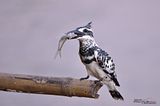These photos of male Kentish Plovers (Charadrius alexandrinus nihonensis) were taken a while back during the last week of November. I heard the news from Furuso-san that there were 2 Kentish Plovers, a male and female, staying at the Mochigahama beach. I went there several days later and found 2 male birds instead. One was staying in the Kotsu Center side and another one around Mochigahama side. Both of them were quite obliging but the one near Kotsu Center was especially tame. I've never seen any Kentish Plover as tame as this one before. I took a few videos of it too and you can see how close I was able to approach it.



Male Kentish Plover (Charadrius alexandrinus nihonensis)
Here's the video of the tame one. It seems to be in an almost full breeding plumage. It's interesting how these plovers moult into breeding plumage so fast. The population that winters in Thailand and South-east Asia wouldn't have the same orange cap and black marks at this time of year. Male and female birds would normally be looking the same in the wintering grounds. Maybe it's because these plovers in Japan don't migrate? Some of them might migrate to eastern parts of SE Asia (like Borneo), but some might stay in Japan throughout the whole winter (like the ones in Beppu) and begin to mate earlier like other resident birds?



The race 'nihonensis' or 'eastern' Kentish Plover seems to be much paler than the nominate race 'alexandrinus' that winters in most parts of SE Asia. I've never seen any male bird in Beppu that has completely rufous crown in breeding plumage like ones that winter in Thailand. The legs are also much paler. Most of the birds that winter in Thailand look like this when they moult into full breeding plumage. Below are some more pictures of the same male bird taken a few days earlier exactly at the same spot.




The same male Kentish Plover (Charadrius alexandrinus nihonensis)





The other bird I found that was staying on the Mochigahama side was still possessing more non-breeding feathers. Its black bands on the breast sides, face and forecrown were still not as dark and clear as the one near Kotsu Center. It was a little more skittish and didn't let me get as close as the other one. I was wondering about where did the female bird go. I've never seen a female bird at Mochigahama Beach before, but I've seen quite a lot at Sekinoe Beach, but all of them are so shy over there. It seems like I've had enough photos of the males. Now it's time for me to get some decent shots of the ladies.





















.jpg)

3 comments:
Brilliant, especially the one where it's lying on its stomach......
Beautiful study of these individuals. They are really nice models for you.
Just superb, crisp shots, even if the bird was "tame" as you say. Some interesting thoughts on the variability of the plumages you see. Like you say maybe they moult quickly because they need to appear in breeding plumage for a longer period.
Post a Comment